Interview with Sabine Pinon: A World of Pigments
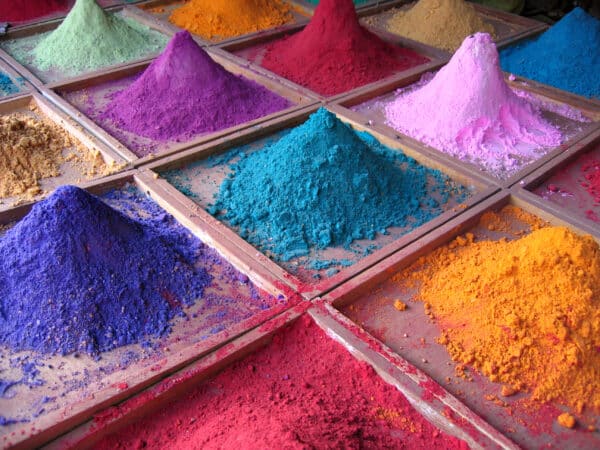
Pigments on a market stall. Credit Dan Brady
The pigments found in paintings, sculpture, mosaics, stained glass, ceramics and many other mediums will so often have their own context, connotation and history. A fundamental part of art history since the beginning of time, the sourcing, mixing and application of pigments through generations, tells us a great deal about the changing world of an artist and their studio practice.
It is a fascinating and lengthy subject and today we are fortunate enough to have been able to explore the world of pigments with art materials historian and expert, Sabine Pinon. An author and historian of art and art materials, Sabine has kindly answered an array of questions for us that give us some welcome insight into the world of pigments, including from the artist’s perspective.
What is a Pigment?
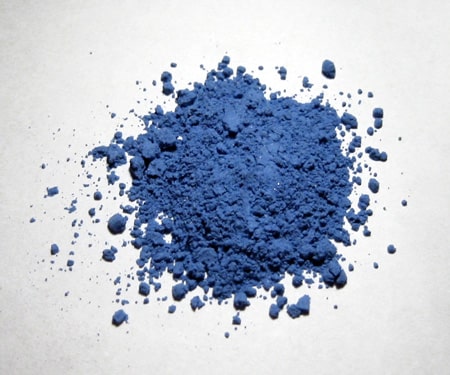
Natural Ultramarine Pigment
Firstly, it is helpful to understand exactly what we mean when we use the term pigment.
Essentially, a pigment is a material or substance that is coloured. The key characteristic that makes a pigment capable of becoming a paint is that it is insoluble in water, oil or resin. This means it won’t bleed or travel after being ground, mixed with a binder and applied to the artist’s canvas of choice. In contrast, a dye is a substance which, while also used as an agent of colour, is soluble and cannot be contained or controlled in the way a pigment can.
Interestingly, a dye can become a pigment if it is chemically or electrically connected to an insoluble particle, thus giving it the ability to be ground. This is known as a ‘lake’ and it is a complicated process to go through.
Pigments can be found throughout the natural world, but also can be created via synthetic manufacturing. Almost all pigments will have their own unique crystalline structure which reacts differently to light, causing it to be the colour, or hue of a colour, we perceive through the human eye. The slightest changes in this structure causes a pigment to alter its perceivable tone.
Interview With Sabine Pinon
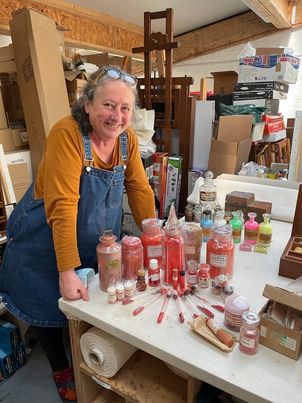
Sabine Pinon
Sabine Pinon is a fountain of knowledge when it comes to pigments and their history having studied their history and written extensively about her work. Having grown up and worked in the world of art, Sabine’s subsequent passion for art materials has seen her dedicate an enormous amount of time to researching and consolidating their history. Today Sabine has generously answered a number of different questions on pigments for us, which we are delighted to be able to share with you here!
Q. First of all, we are fascinated by your research in the field of pigments. Could you tell us what it was that originally drew you to the history of art materials?
My mother was an art restorer who worked for the Louvre, the French museums and the Musées de la Ville de Paris. This meant I was immersed in this fascinating world from a very early age. When she was preparing for her entry exam, I was ten, but I believe I knew the recipe for Rabbit Skin Glue even better than she did! Nevertheless, there is only so much you will learn from someone else’s passion; at first mine was literature. But life has many twists and, after starting an English bookshop in Paris with a friend, I ended up working for an art expert in my early thirties. Later I became a graphic designer of book covers (whilst researching artworks from all over the world).
Finally, my husband and I landed in Australia, where we took over a little gallery/ framing shop and promptly added art supplies… It was quite a learning curve! Even whilst selling pigments, it took me many years to completely understand that these were the colouring agents of all of my art materials. When I became passionate about them, it took many more years to refine my knowledge of them and their intriguing, volatile nature!
Q. Your studies have been extensive – is there a part of the process of working with pigments that has come to fascinate you the most? For example, the binders used, the longevity of some colours, the way that light has impacted others etc.
I am often fascinated by one thing after another, so probably no favourites….My MA essay on pigments ended up being a “Book of Stories” in which pigments clustered (something they actually do, to the paintmakers’ despair!) around rather unexpected themes such as Do pigments have a sex? (they have families after all) and Could Pigments be sexist? Or have value(s)? Such as Monetary Matters, Spiritual Values, Aesthetic and Moral Values? To rework the body of knowledge that I have in these new and different contexts makes it all come alive to me.
Q. Being based in Australia, have you found key differences in natural pigments across continents and through the centuries, or do the differences appear through the variables in the manufacturing processes?
Our planet is pretty abundant in Earth pigments all over! Painters might find more Burnt Sienna in Sienna or Terre Verte in Cyprus but one will find similarly coloured earths elsewhere. However, they may not have the exact same silica content or other trace elements, which makes the specific pigments like Burnt Sienna a little bit more precious to the artists.
On the other hand, other natural pigments can be quite rare. Obviously, precious and semi-precious ones are not found everywhere (or they would not be so precious!) Gold is obvious, but Cinnabar, Malachite, Azurite, Cobalt, Lapis Lazuli, Orpiment etc. were only found here and there across the planet. As a result, you could say Pigments are hodophiles (they like to travel!) and have done so extensively alongside beliefs, gods, silks, plagues, pearls, porcelain and poetry but, mostly… spices!
For millennia, I believe Earth pigments, these fragments of a place, related more strongly to us if that place was ‘ours’. They might even have defined us. We know that Aboriginal Australians travelled for thousands of miles around the continent for centuries and that ochres were exchanged and offered. However, I am not so sure ochres went ‘walkabout’ elsewhere as much. Melonie Ancheta, who researches the use of Vivianite along the Northern Northwest coast of the American continent, seems to think: “Sourcing materials from distant regions or through trade would decrease the significance of those materials and reduce the likelihood for use on ceremonial or spiritual objects.”
This being said, to the amazement of researchers, when they recently analysed the frescoes at Lascaux with a new non-invasive apparatus, where they expected Bone Black or Charcoal, they found complex mixtures of scarce manganese oxide minerals, including groutite, hausmannite and manganite. Can we comprehend to what length these forefathers and mothers had gone to obtain such knowledge of pigments? How far and for how long had routes to the source of these colourful beauties existed? In that specific case, and if indeed the Manganese Black came from there, the closest known Manganese-rich geological site is a good 250 km away from the cave!
Variables in the manufacturing processes of natural pigments exist, of course. Chinese Vermillion was praised higher than the one made in England. Which is why it kept being imported from the 18th century (and ‘fake’ little packages of 14 ounces of the pigment with Chinese characters printed on them began to circulate everywhere too!) But in today’s globalised world, I would say most often one wouldn’t know where most ingredients have been sourced, not even where they were processed. Manufacturing modern pigments can involve many steps, sometimes up to 20 syntheses, so that usually, not even pigment makers perform them all.
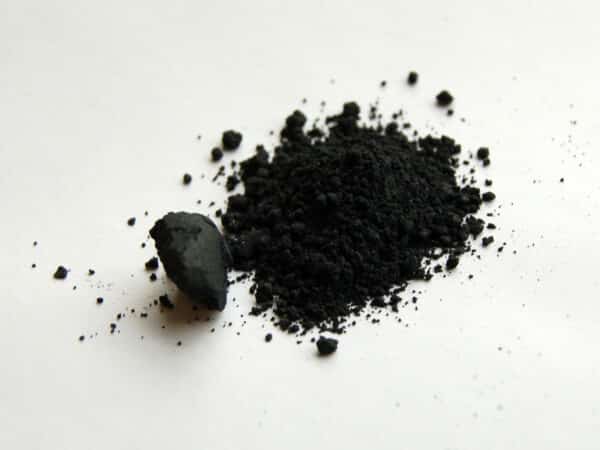
Manganese Black
Q. We are really interested in pigments from the perspective of the artist. Could you share more about how it would have been for the artist in their studio before the invention of the metal tube?
Vendecolori, “Sellers of Colour”, existed in Pompeii, Venice and Florence (selling pigments not paint) and played a crucial part during the Renaissance in enticing painters with many new and rare pigments. These included pigments such as the Persian Cobalt Oxide or the ever so delightful golden Orpiment which they imported from Asia Minor. But times have really changed, and out of the 10 million tonnes of pigments sold worldwide per year, only 1% of total global production ends up in an artist’s tube, pastel or pencil today. It is a niche little market that is very fussy and its requirements are quite different from those needing pigments to paint a wall – transparency is hardly an important quality for them, for example!
What has changed, too, is that painters rarely, if ever, make their own paint anymore. For millennia, every painter would have first been an apprentice in a guild or under the wing of a master. His first years, as Rand (the inventor of the metal tube in 1841) promptly discovered, would probably have consisted of many tedious hours of grinding dense chunks of rocks into a powder, making fresh temperas (the eggs would rot after a few days) and of combining the oils and coloured particles with great precision. Paint was made mainly on demand then, but it is hard to estimate how much and how often this was done.
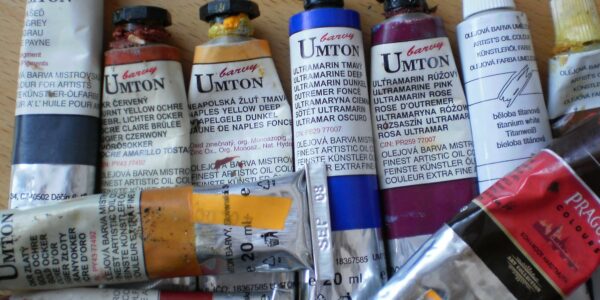
Tubes of paint
Q. What about been the price difference between pigments through the ages?
A considerable price difference has always existed between varying pigments; yellow ochre and gold would hardly have cost the same, even back then. Why is this not obvious anymore? In fact, I believe the art shop might just be one of the very last stores where you’ll get your money’s worth and, while one might still feel like lamenting at the till, in truth, we’ve never had Colour this cheap or accessible before.
When painters needed to travel to Venice or Florence to buy the pigments to execute their commissioned altarpiece, certain pigments were listed as part of the contract since they were so expensive. Moreover, when they arrived, the naive could be sold an inferior grade of lazurite or, even worse, Ultramarine ash, the lowest quality blue. They might even be robbed of their precious goods on the way back home. Many a Colour boat has thus been lost to the Pirates of the Caribbean…
Even today, despite advanced production methods, there are still considerable differences in the price of pigments. This is usually dictated by their rarity or the sheer costs and complexity of production. Ultramarine, now called ‘Lapis lazuli genuine’, didn’t gain the nickname “the diamond of all colours” only for its sparkling effects that can only be seen in the crushed stone variety and under the microscope. In 2020, 100 grams of top quality lapis pigment retailed at one of the best suppliers for €1,640 before taxes, whereas the same quantity of its synthetic replacement, Ultramarine in a tube, went for €3.60!
Without venturing further into the rarified or near-obsolete pigments, some families of colours are produced with other costly elements. Separating the metal in cadmium and cobalt ores is an expensive process, for example. Compounded with sulphur and selenium (Cadmium Yellow and Red), zinc (Cobalt Green), tin (Cerulean Blue) or aluminium (Cobalt Blue), these then need to be fused. In the case of Cobalt Blue, for example, it takes ten hours in an oven at 1100ºc – another expensive procedure.
Ultimately, it isn’t surprising, really, that 100 grams of happy artist quality Cobalt Blue costs $16.50, more than five times the price of Ultramarine in the same catalogue.
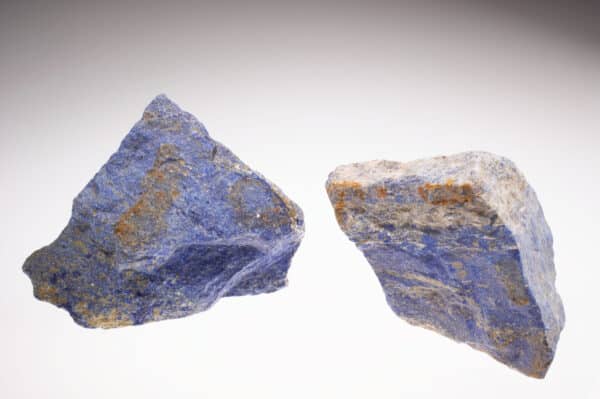
Semi-Precious Gemstone Lapis_Lazuli
Q. We particularly enjoyed reading about your discovery of a letter in the archive of L.Cornelissen & Son regarding Isinglass, might you be able to tell us a bit more about correspondence between British art suppliers and how they acquired their pigments?
If you looked at the ingredients of an Alchemist’s cupboard in Medieval times, it actually reads like a pigment manufacturer’s one: Alkaline salt, Alum, Antimony, Arsenic, Auripigmentum (that’s Orpiment), Bismuth ore, Chalk, Cinnabar, Saffron of Mars (that’s Hematite aka Red Ochre), etc.
Yet what precipitated the demise of these more philosophically-minded gents in the 19th century was the growing understanding and nomenclature of The Elements. Armed with this new Table, a more ‘respectable’, theory-based discipline emerged: chemistry. However, whilst these chemists understood the potential of newly discovered elements in the production of colour, not only were they rarely exploited immediately but they were often used for other industries in which drying time was of little to no importance.
Subsequently, some people realised the necessity to bridge the gap between Science and Art and another profession evolved: Colourmen. Colourmen (those who sell or make paint) were often chemists themselves but were not always colour-makers (those who made pigments) at the same time. Colourmen quickly became the go-to person for artists. Today, even if some historical pigments are still made especially for them, the last colourmen usually still only make paint.
Working on Cornelissen’s pigment archive (the last Artists’ Colourman in the UK) made me realise how significant the role of these highly inventive men had been in the 19th century,in England. Winsor, Robertson, Reeves and Rowney amongst others made many discoveries into the possibilities and improvements pigments can make to paint / art materials in general. Some of their discoveries are still in use today.
Later, I realised that Colourmen had existed in England for much longer than that. Even if most are now entirely forgotten, their purpose seems to have changed very little from the first one we know of: artist and teacher Alexander Browne, who advertised himself via the 1675 edition of his book Art Pictoria.
Q. Finally, it is clear that we have a deep love for the colour blue, could you tell us a little bit about Egyptian Blue and what makes it such a special pigment?
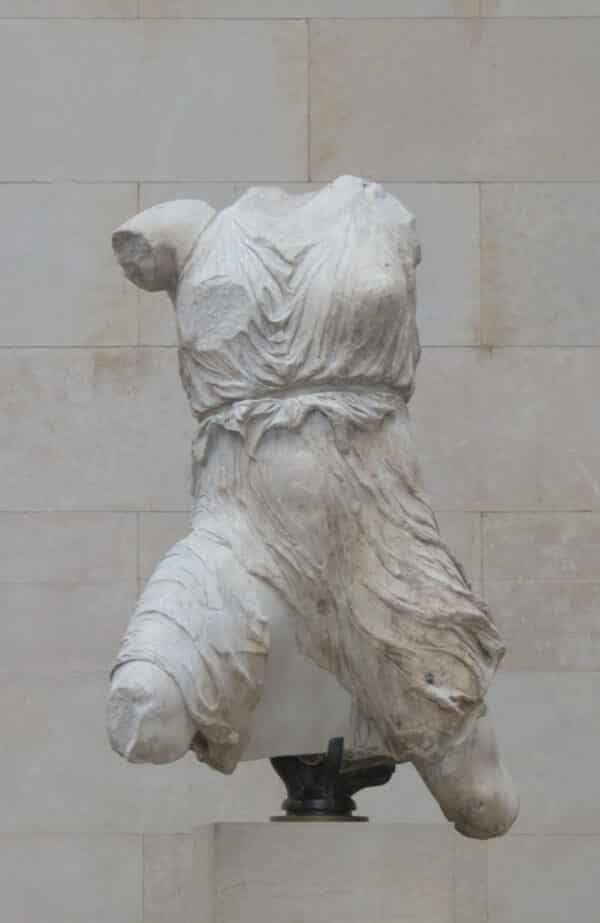
The Marble Sculpture of Iris, on which Egyptian Blue was discovered. Credit: Oxyman on WikiCommons
Amazingly early on, we found out how to synthetically manufacture some inorganic pigments. The oldest one, Egyptian Blue or frit, might have been discovered even earlier in Mesopotamia. There is no doubt that the Egyptians’ ceramic industry knew precisely how to mass-produce this subtle blue crystalline pigment at the time of the construction of the Pyramidsof Giza – around 4500 years ago. Interestingly, even then they were aware of its then unique nature, reflected by their name for it: hsbd iryt, aka artificial lapis lazuli.
Egyptian Blue was eventually produced and used by the Romans all over the Mediterranean. Unfortunately, however, most likely due to the chaos at the end of the Empire the recipe was forgotten. Only in rare occurrences was it ever detected again, in a handful of paintings here and there. This was possibly down to an old pigment stash being found and used.
The recipe is complex and implies chemical knowledge and firing mastery. The kiln in which the blended ingredients are fused (1 part lime (calcium oxide), one part copper oxide and 4 four parts quartz (silica)) has to be between 800 to 900 degrees Celsius precisely. More lime and more heat and you get green frit!
It turns out that the brittle blue material, which could then be ground to a soft, tender, fine blue pigment had another trick up its sleeve. One that would take many more centuries for us to ‘see’, thanks to technology and the way the pigment actually absorbs visible radiation but re-emits infrared radiation. The significance of this was discovered through a well-suited lady for the job: Iris, messenger of the gods and goddess of the rainbow (she also gave her name to the apple of our eye, the iris and to iridescence!).
In truth, Giovanni Verri and his team of researchers at the British Museum helped too. In 2006, they discovered that Egyptian Blue has an exceptionally strong luminescence and emits a glow under fluorescent light. Not necessarily a message from the gods, perhaps, but a sure signal of infrared radiation. Similar to the one that passes between our televisions and our remotes, our car keys and locks, etc.
Our eyes can’t see this emission, of course, but it can be recorded with a camera equipped with modified filters. With this technique, even one single grain of the luminescent pigment can be detected and prove the presence of paint and patterns on a surface: stone, fresco, painting. And, in what was a brilliantly serendipitous discovery, it was Iris’ belt (part of an incredible sculpture that had once been part of the so-called Elgin Marbles from the top of the Acropolis) which gave the definitive clue curators were desperate for indeed, the Parthenon was once painted!
* * * * * * * * * * * * * * *
We are incredibly grateful to Sabine for providing us with these absolutely fascinating and detailed answers. Our knowledge of pigments and their history has been significantly heightened! Having completed her MA in Art & Material Histories, Sabine is currently working on her forthcoming book Hues in Tubes, so you will be able to follow her research journey and find out more of her discoveries. However, in the meantime, we encourage you to explore Sabine’s extensive and wonderfully informed blog on the subject: In Bed with Mona Lisa.
Blue Pigments in the Blue & White Collection
Here at Blue & White Company we are certainly familiar with some of the gorgeous blue pigments that have been mentioned in Sabine’s interview and you can read our previous journal entirely dedicated to Cobalt blue here!